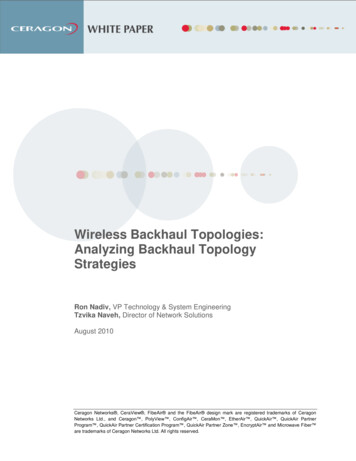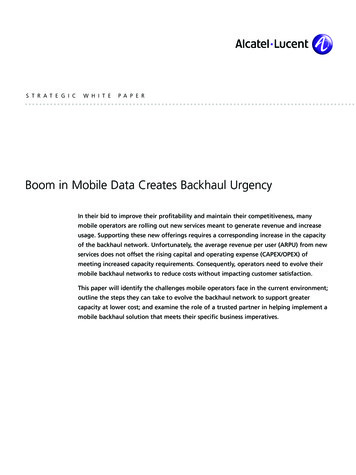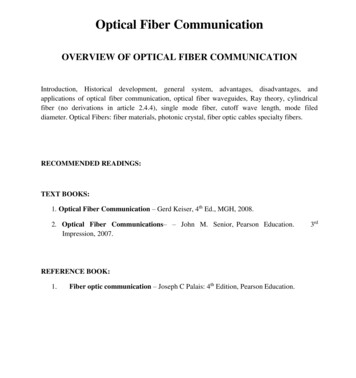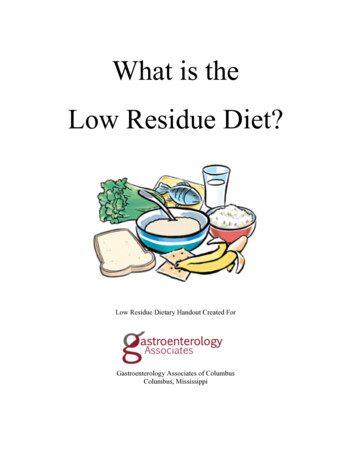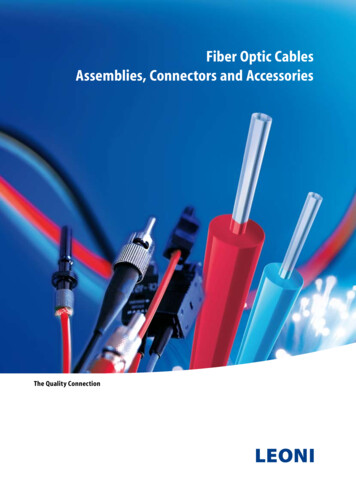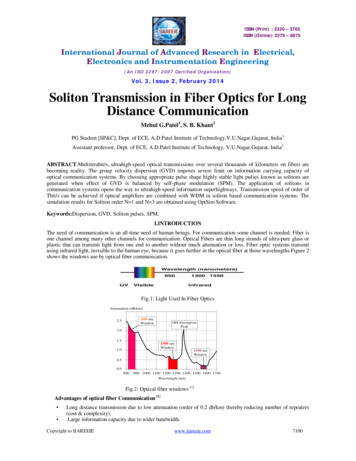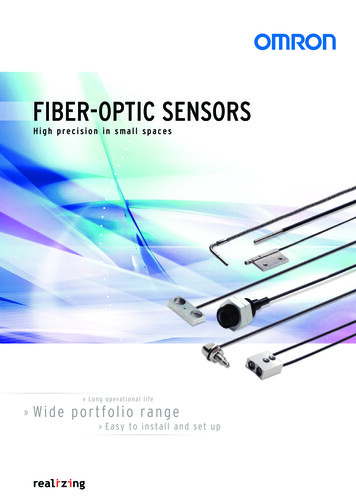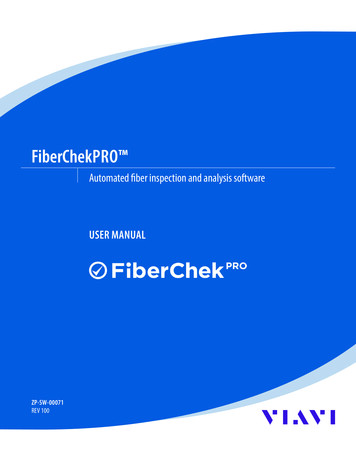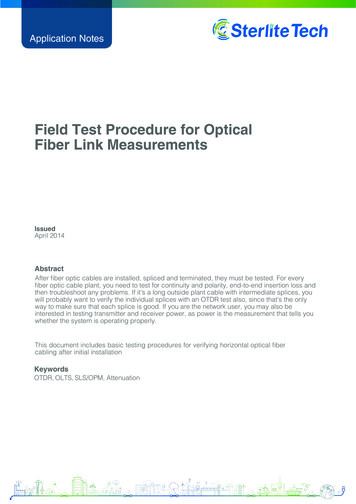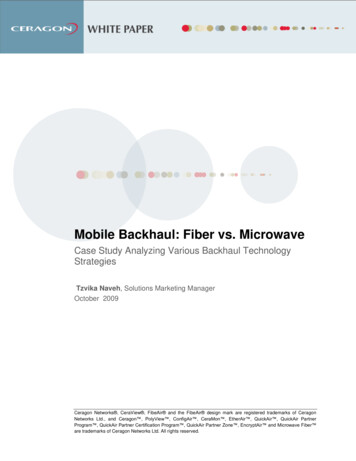
Transcription
Mobile Backhaul: Fiber vs. MicrowaveCase Study Analyzing Various Backhaul TechnologyStrategiesTzvika Naveh, Solutions Marketing ManagerOctober 2009Ceragon Networks , CeraView , FibeAir and the FibeAir design mark are registered trademarks of CeragonNetworks Ltd., and Ceragon , PolyView , ConfigAir , CeraMon , EtherAir , QuickAir , QuickAir PartnerProgram , QuickAir Partner Certification Program , QuickAir Partner Zone , EncryptAir and Microwave Fiber are trademarks of Ceragon Networks Ltd. All rights reserved.
IntroductionThe advent of 3G and 4G mobile services brings with it a surge in data traffic, which in turnputs a strain on existing cellular networks. Nowhere is the demand for more available capacityfelt more than in the Backhaul.Looking into their backhaul options, operators can choose one of three physical mediums;copper, fiber or microwave. A recent report by Heavy Reading Research1 estimates thatmicrowave represents nearly 50% of global backhaul deployments. As shown in Figure 1, thereport also finds that the use of microwave is not distributed evenly across nations. In fact,microwave is frequently deployed in developing markets and in emerging markets in whichfiber is not available. Microwave is also frequently used in developed markets as analternative to costly line-leasing services offered by Telecom incumbents.Copper networks, that according to Heavy Reading make up for nearly 20% of all backhauldeployments, are likely to decrease due to their limited capacity support and their inability toscale in a cost efficient manner. Looking forward, fiber is expected to take the place of copperbased wire-line connections, and increase its overall share (albeit not at the expense ofMicrowave).Figure-1: Estimate for the global share of cell-site connectivity of microwave fiber and copper at the end of 2008and Global layer 1 backhaul technology forecast (Source : Heavy Reading)This paper compares two self-owned backhaul alternatives: fiber and point-to-pointmicrowave. In the following chapters we will attempt to shed some light on the considerationsthat impact the decision making process of operators when choosing the right backhaul optionfor their network. We will also cover regional aspects and present a case study based on reallife parameters.1Ethernet Backhaul Quarterly Market Tracker, Heavy Reading Research, July 2009WHITE PAPER Fiber vs. Microwave2
Comparing Microwave with Alternate TechnologiesThis discussion focuses on fiber vs. microwave assuming a cost and capacity evolution asdescribed in Figure 2 below.Figure-2: Mobile backhaul technology evolution. Ethernet microwave appears as a reasonable solution ascapacity increase and backhaul cost decrease.For the sake of discussion let us consider the relevance of two additional alternativesinfrastructure; Copper and Cable. Copper based services are designed forE1 or DS1services. Supporting 1.5-2Mpbs, Copper lines do not scale easily to provide adequatebandwidth at a distance above few hundred meters to support broadband usage of 3G andemerging LTE/4G technologies. For longer distances, bonding configurations are required inwhich monthly costs increase linearly with bandwidth requirements. xDSL technology wasthought to be a good method for offloading data traffic, but this too was abandoned in favourof fiber.Another promising contender is backhaul based on Multiple System Operator (MSO)infrastructure leveraging DOCSIS 3.0 high capacity to backhaul wireless base stations. Tworeasons make it less relevant for this discussion; First, it is a shared media technology,making it difficult to deploy with the right traffic engineering. Secondly, MSO and Hybrid-FiberCoax (HFC) foot print is limited to only a few countries such as the US, UK and Germany. Inrest of the world, Cable footprint is considered insignificant. On the other hand, in placeswhere MSOs play and own substantial fiber assets, they can leverage those assets to offerhigh capacity, fiber based Ethernet services for cell sites situated near their POPs.Operators have traditionally used the following basic strategic guidelines to decide whichtechnology to use in their backhaul:WHITE PAPER Fiber vs. Microwave3
1. Incumbent operators: Self deploy and rely as much as possible on existing facilities,while laying new fiber when and where an up-selling is possible. This assumes largecapital resources and long-term ROI models2. Challenger/competitive operators: Challengers typically have more limitedresources and a limited installed base, leading to two major backhaul strategies; Oneis to self-deploy backhaul relying almost entirely on microwave (examples includeOrange Spain and Orange UK both with over 95% microwave in their network). Onthe other hand, some operators opt for leasing copper or fiber from incumbents orother challengers (such as T-Mobile US that has only 5% self built microwave andrelies almost entirely on leased line services).The reasons for choosing one way or the other are related to ownership structure,available cash during inception and long term strategic plans.3. Rural Broadband operators: Mainly self deployed microwave. Leased fiber may beused for some of the core when the price is right.Table 1 summarizes briefly the main difference between microwave and fiberMicrowaveCapacityRegulationDistance influence onCosts and DeploymentTimeTerrain Up to several Gbps Unlimited Requires spectrum Visual impact considerationsRequires right of ways andinfrastructures; renovation constructionworks after trenching Cost per link with someincremental cost with thedistance Costs increase per feet/meter Deployment time increases linearly withdistance Becomes costly when trenching indifficult terrain (Mountains, Desert,swamps, rocky plains or Jungles) Accessibility - requires access forvehicles along the trenching path Fiber, in most cases, cannot berelocated Copper ducts may be reused for fiberlines Normally, not influenced , except forfloods Fast deployment time Suitable for any terrain Requires line-of-sightbetween two link end-points Reuse optionsClimateFiber linesEquipment can bedisassembled and relocatedsomewhere else Influenced by climate Adaptive modulation and aproper link planning reducesclimate effectsTable-1: Microwave and Fiber considerationWHITE PAPER Fiber vs. Microwave4
Regional Differences in Microwave Backhaul AdoptionGlobally, an increasing percentage of new backhaul investment is in microwave. But toestimate demand, one needs to understand how acceptance differs on a regional basis aswell as by each individual carrier. Several such examples are depicted in table 2 below:CountryCarrierLegacy Installed BaseStrategic DirectionItalyVodafoneMainly microwave, following a 1995decision to avoid reliance on TelecomItalia’s leased linesSubject to periodic reviewU.K.VodafoneHigh reliance on leased linesAggressive shift to microwaveU.K.“3”Relies mainly on leased lines. Decisionmade in order to avoid initial CapEx hitfrom self-building microwave on top of an 8B 3G license fee and aggressivenetwork rollout expenditureSubject to periodic review, probableshift to microwave in the futureU.K.OrangeHigh proportion of microwave, but earlygeneration of point-to-point microwavenow nearing end of lifeConsidering upgrade options includingnew microwave and fiberU.S.SprintHigh reliance on microwave, using multipleplatformsShift in balance toward microwaveFranceSFRHigh reliance on leased linesAggressive shift to microwaveMalaysiaMaxisHigh proportion of point-to-pointmicrowaveTrialing Point-to-multipointTable-2: Regional Differences in Microwave Backhaul Adoption. Based on Heavy Reading Research, BackhaulStrategies for Mobile Carriers,Regional differences depend on a number of factors including the availability of equipment,spectrum and licence costs, the extent of existing copper and fiber resources andgeographical span. Microwave spectrum is more expensive, for example, in Europe than inAfrica, where the regulatory conditions are relaxed and bandwidth is plentiful. The mobileaffiliates of fixed operators are more likely to use the leased lines and fiber of their affiliate,while “challenger” operators will more frequently rely on microwave. While fiber essentiallyprovides unlimited bandwidth with the aid of wave division multiplexing (WDM), it is expensiveand challenging to deploy. The business case for microwave rests on its ease of deploymentand greater range, performance and flexibility. CAPEX is offset by low OPEX, makingmicrowave more cost effective.WHITE PAPER Fiber vs. Microwave5
Case StudyThis case study describes two self-owned mobile backhaul scenarios, as shown in Figure 3. Itassumes new cell sites (not co-located) that need to be backhauled to the RNC/MME site. Wewill assume the bandwidth required in the range of 25Mbps – 500Mbps and that the changingvariable is the distance from the cell-site to the aggregation site.Figure-3: Mobile Backhaul Case study domainIn our example we assume that Switch/ADM equipment for aggregation is installed at Hubsite. At the cell site we either have switch / MSPP connected to fiber all the way to theaggregation equipment or a licensed wireless microwave link that holds integrated CarrierEthernet switching capabilities (e.g. Ceragon FibeAir IP-10). On the far end of the link, in theaggregation site, we assume we already have a mast in place over the rooftop for backhaulantenna.Let us now consider the set up costs for each of the two backhaul alternatives using costestimates that were recently published by a number of market research firms. As shown inTable 4 fiber trenching costs are highly influenced by population density (i.e. rural,metropolitan and urban), terrain and regulation. In the table below trenching costs alreadyinclude the needed infrastructure renovation construction works and right-of-way.WHITE PAPER Fiber vs. Microwave6
Fiber Optic LinesEthernet Switch or TDM multiplexer 2,500Rural 30Metropolitan 90Urban 130Trenching Costs [ per on works and right-of-wayFiber Costs [ per meter] 7Including fiber, connectors, fusions and testsTable-4: Trenching fiber optic costs. Source –Wireline operatorThe costs of setting up a microwave backhaul link, according to industry average, are shown in Table 5.Wireless Microwave Link (two terminals)Costs- Including equipment cost,installation cost, antenna, and annualmaintenance costs including licensefees1 0 Microwave link 16,0001 1 Microwave link 30,000Trunk(LongMicrowave linkhaul) 40,000Erect new tower at the cellular base station for wireless backhaul 50,000Total 1 0 Microwave link (including new tower setup) 66,000Total 1 1 Microwave link (including new tower setup) 80,000Total Trunk (Long haul) Microwave link (including new tower setup) 90,000Table-5: Wireless point-to-point microwave link costsIn order to compare fiber and microwave not only according to cost and capacity parameters,but also in terms of reliability and distance, our case study shows a 1 1 protected wirelesslink configuration as well as a wireless long- haul Trunk solution alongside the typical 1 0unprotected wireless link.Comparing the various mobile backhaul scenarios versus the increasing distance from thecell-site to the aggregation site, will result the following diagram:WHITE PAPER Fiber vs. Microwave7
Figure-4: Microwave and Fiber backhaul solutions vs. DistanceFigure 4 clearly shows that in Greenfield base-station deployment scenarios - in which newtowers need to be erected for point-to-point microwave - fiber optics are more cost effectiveover short distances (up to 500m/0.3 miles). Yet, in urban environments, tower set-up is notalways required (antennas can be mounted on rooftops for example). In this case themicrowave option becomes much more attractive even at a very short distance.In rural environments microwave becomes more cost effective at around 1.6 Km ( 1mile)when tower set-up costs are involved – though even here, new towers are not always required(in which case microwave is more attractive almost from the get-go). At distances above2.5Km ( 1.7 miles) self-owned fiber becomes so expensive, that even a protected Trunksolution becomes more cost effective.Table 3 below sums up a number of assumptions used form the case study discussed in thissection. It is important to mention these assumptions as they might tip the scale in favour ofone technology or another.WHITE PAPER Fiber vs. Microwave8
AssumptionExplanationImpact onMicrowaveNo up-sellingopportunitiesOperators might leverage existing facilities to generatemore revenuesNegativeNeed to erecta new towerfor wirelessbackhaulTower cost is roughly 50,000 to construct, and in thiscase all cost is associated with the backhaul budgetand not part of the RAN budget. Obviously a morerealistic approach would share these costs as towers orroof top poles are required for the base station andtherefore should not impact the microwave case.PositiveRepeatersAt long distances, Microwave links would requireexpensive repeaters while fiber repeaters are lesscostly and anyhow are required only after very longdistances. This is not part of the discussion as thesestate level investments have more complex businessmodelsNegativeTime to deliverTime to deliver is not monetized as Microwave is analmost instant media while fiber projects may takeyears to approve and deployPositiveAccountingrulesmakes for some operators long term investments infiber, deprecated over 20 years a smart investmentwhile radios are deprecated in shorter cycles (5-8years) making it a better investment for othersNegative /PositiveTable-3: Microwave and Fiber simplicity assumptionsSummaryThough fiber-based networks can easily support the rapid growth in bandwidth demands, theycarry high initial deployment costs and take longer to deploy than microwave. In most casesthe Return-On-Investment (ROI) in fiber installations can only be expected in the long term,making it hard for operators to achieve lower costs per bit and earn profits in the foreseeablefuture.Wireless microwave backhaul solutions on the other hand are capable of delivering highbandwidth, carrier-grade Ethernet and TDM services. Microwave is suitable for all capacitiesup to several Gbps over a single link and may be scaled up to multiple Gbps usingaggregated links techniques. Unlike fiber, wireless solutions can be set up quickly and aremuch more cost efficient on a per-bit basis from day one.From the market data shown in this article and the case study it presented, it is clear thatleased copper lines are becoming too costly - and too inefficient - for the increasing capacitiesWHITE PAPER Fiber vs. Microwave9
required for 4G/LTE backhaul. It was also shown that fiber optic sweet spot relies both in shortbackhaul distances and at aggregation sites where ultra high bandwidths are required.Wireless microwave solutions on the other hand, offer a versatile backhaul option for bothshort and long-haul deployments. At distances over several hundred meters, Microwave offersa much better cost-per-bit ratio than fiber, without compromising on availability or reliability.The main reason for mobile operators to use microwave for backhaul is total cost ofownership. With few exceptions, microwave emerged as the de-facto solution for access andaggregation backhaul of mobile traffic, both for voice and data services.WHITE PAPER Fiber vs. Microwave10
GlossaryADMAdd/Drop MultiplexerDOCSISData Over Cable Service Interface SpecificationDWDMDense wavelength division multiplexingHFCHybrid Fiber CoaxLTELong term EvolutionMMEMobility Management EntityMSOMultiple System OperatorMSPPMulti-Service Provisioning PlatformRNCRadio Network ControllerABOUT CERAGONCeragon Networks Ltd. (NASDAQ: CRNT) is the premier wireless backhaulspecialist.Ceragon’s high capacity wireless backhaul solutions enable cellular operators andother wireless service providers to deliver 2G/3G and LTE/4G voice and dataservices that enable smart-phone applications such as Internet browsing, musicand video.With unmatched technology and cost innovation, Ceragon’s advanced point-topoint microwave systems allow wireless service providers to evolve theirnetworks from circuit-switched and hybrid concepts to all IP networks.Ceragon solutions are designed to support all wireless access technologies,delivering more capacity over longer distances under any given deploymentscenario.Ceragon’s solutions are deployed by more than 230 service providers of all sizes,and hundreds of private networks in more than 130 countries.Visit Ceragon at www.ceragon.comWHITE PAPER Fiber vs. Microwave11
The advent of 3G and 4G mobile services brings with it a surge in data traffic, which in turn puts a strain on existing cellular networks. Nowhere is the demand for more available capacity felt more than in the Backhaul. Looking into their backhaul options, operators can choose one of three physical mediums; copper, fiber or microwave.
